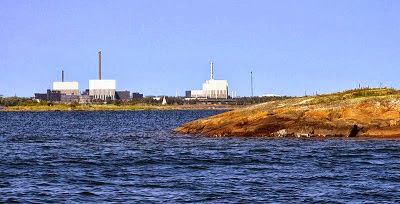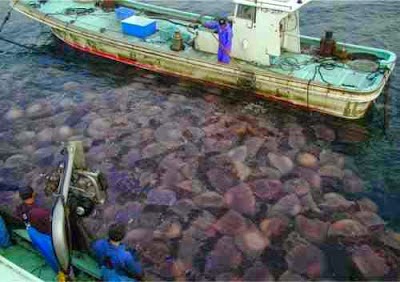Jellyfish (and other gelatinous organisms) form a major part of the
marine ecosystems, and in parts of the world have been shown to be increasing
due to human activities, which often remove species that would otherwise
control Jellyfish numbers. Many Jellyfish species undergo periodic ‘blooms’ in
which very large numbers appear due to some environmental stimulus, then after
briefly dominating the local environment, dying en masse and sinking to the
ocean floor. This represents a major relocation of nutrients from the pelagic
zone (i.e. open water) to the seafloor, and is likely to have some impact on
life there. While the rapid consumption of Fish carcasses on the deep ocean
floor is well documented, the fate of Jellyfish in a similar environment is
unclear, and there have been sightings of masses of Jellyfish on the seafloor
off the coast Côte d’Ivoire and in the Gulf of Oman which were untouched by
scavengers, leading to speculation that such carcasses would be broken down
only by bacterial action, with the nutrients then incorporated into marine
sediments and lost to the ocean ecosystem.
In a paper published in the Proceedings of the Royal Society SeriesB: Biological Sciences on 15 October 2014, Andrew Sweetman of the InternationalResearch Institute of Stavanger, Craig Smith of the University of Hawaii atManoa, Trine Dale of the Norwegian Institute for Water Research and DanielJones of the National Oceanography Center at the University of Southampton
describe the results of a series of experiments to determine the fate of
Jellyfish carcasses on the ocean floor.
Sweetman et al. took frozen
and thawed specimens of two Jellyfish species, Periphylla periphylla and Cyanea capillata
and of the Mackerel, Scomber scombrus,
and placed them on plates with attached cameras that could be lowered to the
ocean floor. Fresh (unfrozen) specimens of Periphylla periphylla
were also used. The samples were then lowered to the seafloor in the
Sognefjorden off the coast of Norway in October 2012, an area where the water
is about 1250 m deep. To ensure that the different experiments did not
interfere with one-another (deep marine scavengers are thought to hunt largely
by sense of smell), the samples were deposited at least 2 km apart.
All of the samples were rapidly consumed, being visited by a number
of scavengers including the Atlantic Hagfish, Myxine glutinosa, a Galatheid Crab, Munida tenuimana, a Decapod Shrimp, probably Pontophilus norvegicus, and large numbers of Lysianassid Amphipods, Orchomenella obtusa, showing that
nutrients in the bodies of Jellyfish falling to the seafloor in the
Sognefjorden are clearly not lost to the ecosystem, being instead recycled by
marine scavengers.
(a) Myxineglutinosa
scavengers swarming at the Scomber scombrus
bait. (b) Myxine glutinosa voraciously
feeding on thawed Periphylla periphylla
bait. (c) Myxine glutinosa and Munida tenuimana feeding on a single
fresh Periphylla periphyllacarcass.
(d)Munida tenuimana and Decapod Shrimp
feeding on thawed Cyanea capillata
bait. The black bait plate is 50 by 50 cm with gridlines separated by 5 cm. Sweetman et al. (2014).
However the different scavengers did show preferences for different
prey, suggesting that changes in Jellyfish abundance does have an impact on the
seafloor ecosystem. The Mackerel, Scomber scombrus,
samples attracted large numbers of Hagfish, Myxine glutinosa,
who consumed the majority of the high nutrient flesh, followed by a second wave
of invertebrate scavengers, primarily Galatheid Crabs and Lysianassid Amphipods
who consumed the rest of the corpse. Hagfish were also the first to arrive at
the Periphylla periphylla sites,
preferentially consuming some tissues (probably the high energy gonads) before
leaving. They were then replaced by a phase of consumption by Galatheid Crabs
and Lysianassid Amphipods, then finally a third phase of consumption by the
Decapod Shrimps, which had shown little interest in the Mackerel bait. The
Hagfish largely avoided the Cyanea capillatabait,
possibly due to the large amount of mucus this species produces, which is toxic
to fish and may be noxious to Hagfish even after the Jellyfish has been dead
some time.
These findings are significantly at odds with observations made
previously off the coast Côte d’Ivoire and in the Gulf of Oman. Sweetmanet al. suggest that in these instances
large build-ups of inorganic carbon, sulphide compounds and ammonium may have
made the local environment hostile to the scavengers, resulting in the
persistence of Jellyfish carrion on the seafloor. Alternatively this may be the
result of seasonality; the Sognefjorden experiments were carried out in
October, a time of year when Jellfish (and other plankton species) die-offs are
expected to occur, and when deep-sea scavengers may be primed to look for this
source of nutrients. It is possible that Jellyfish carcasses persist for longer
at other times of year because scavengers are not seeking them, or are engaged
in other behaviour.
See also…
While instantly familiar and biologically simple, Jellyfish (Scyphozoa)
are still in many ways poorly understood, with frequently poorly
understood life-cycles and population structures, leading to unexpected
shifts in population and sudden blooms of large numbers of Jellyfish,
which can impact on commercial fisheries or...
The Oskarshamn Nuclear Power Plant in Kalmar County on Sweden's southeast coast was forced to...
Many scientists and conservationists are worried about the state of the world's oceans. Many important marine ecosystems are known to be under stress: once prolific fisheries have collapsed; dead zones lacking oxygen...
The Oskarshamn Nuclear Power Plant in Kalmar County on Sweden's southeast coast was forced to...
Many scientists and conservationists are worried about the state of the world's oceans. Many important marine ecosystems are known to be under stress: once prolific fisheries have collapsed; dead zones lacking oxygen...
Follow Sciency Thoughts on Facebook.




